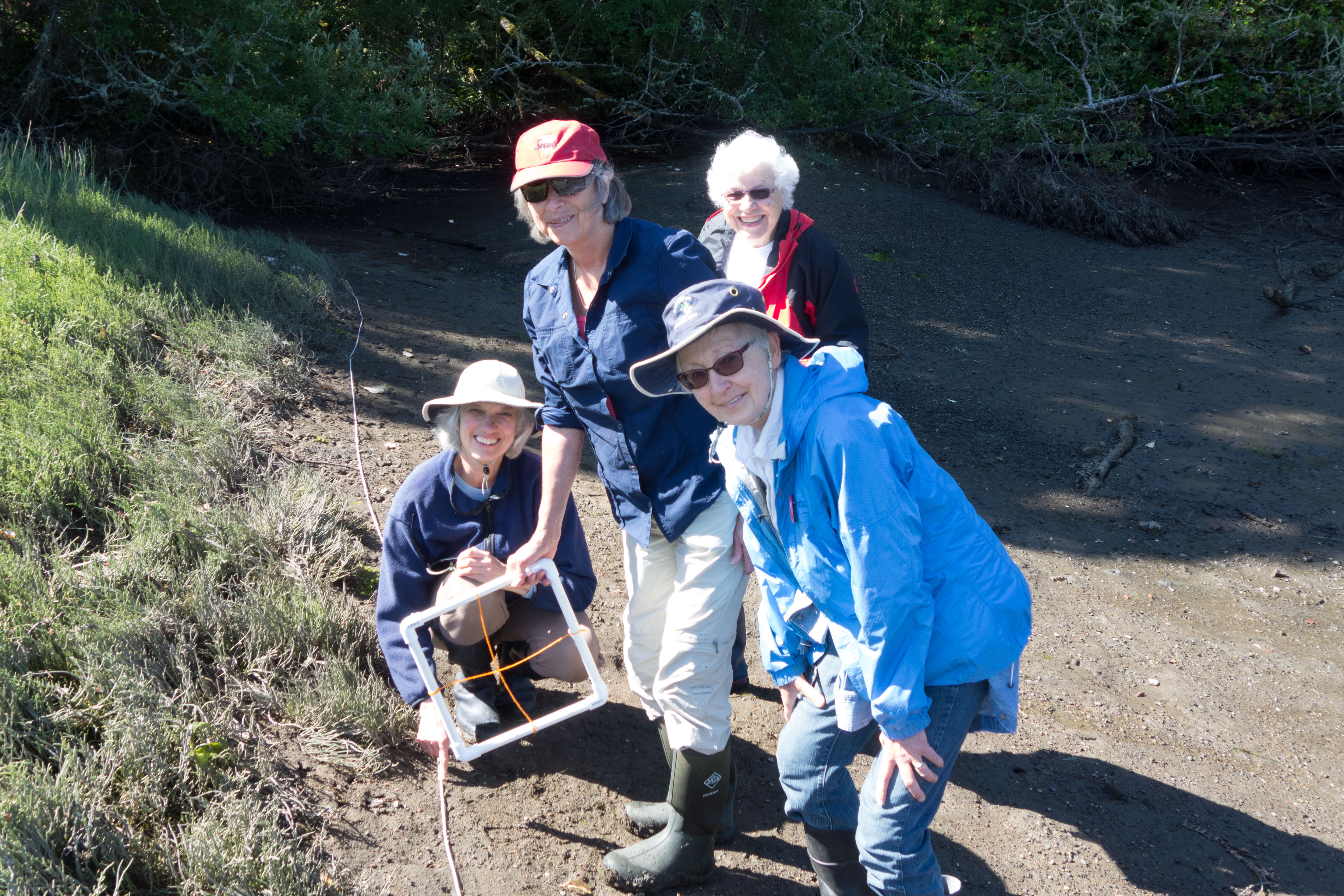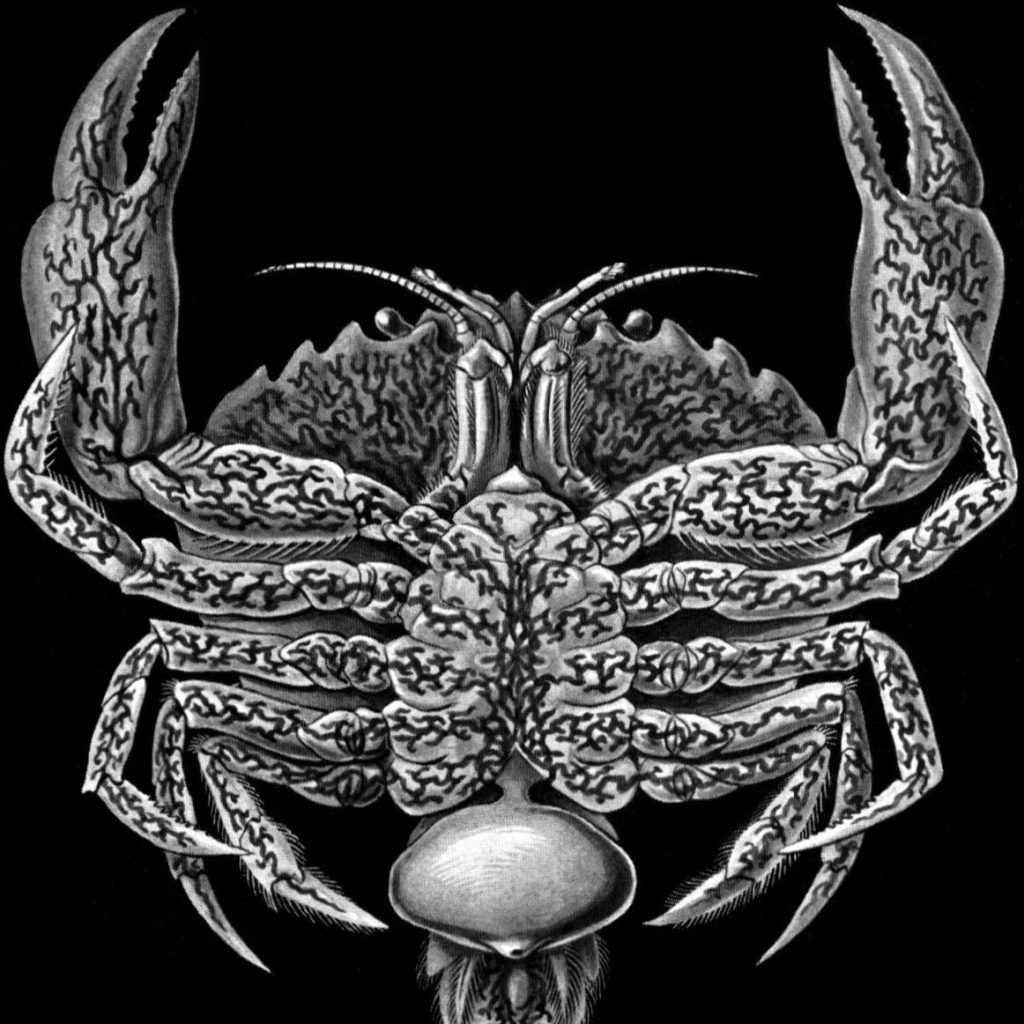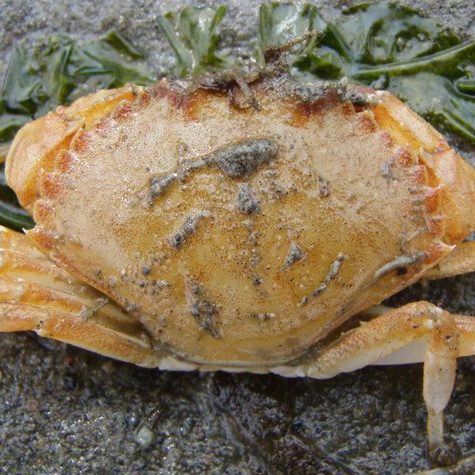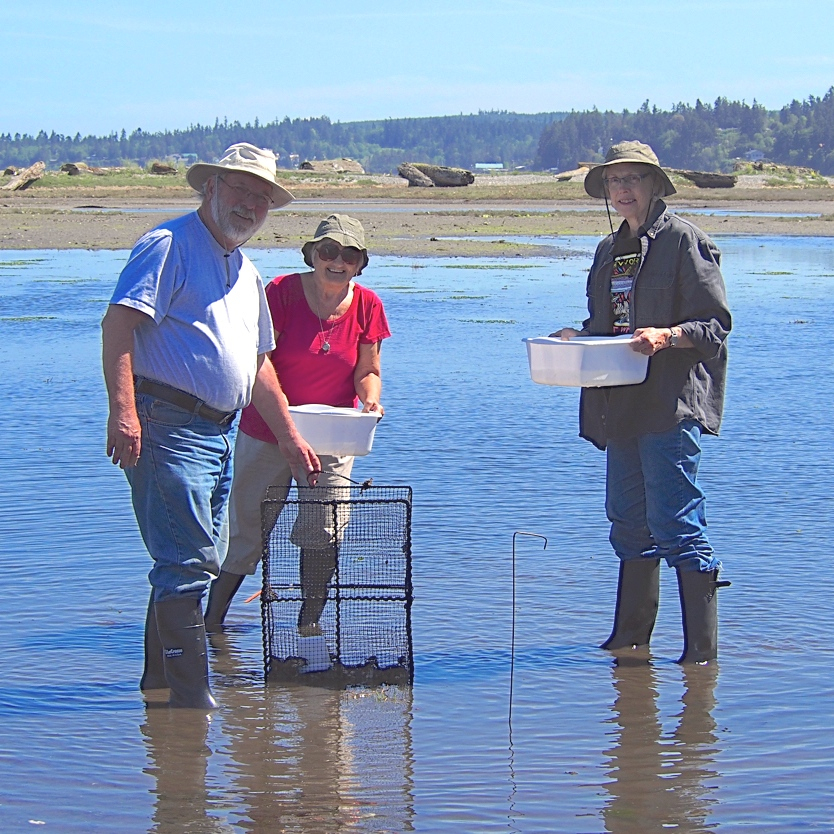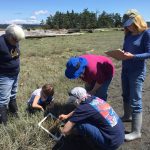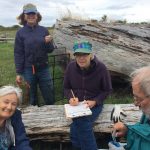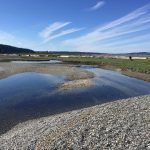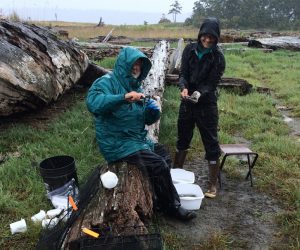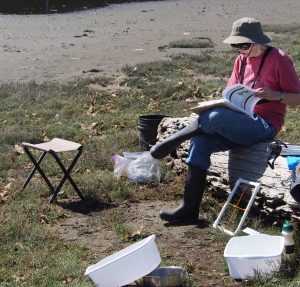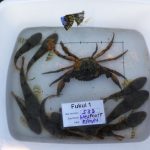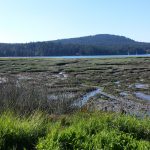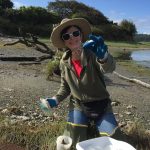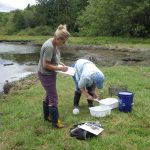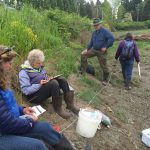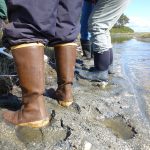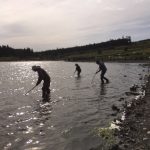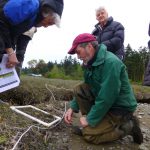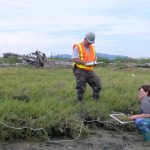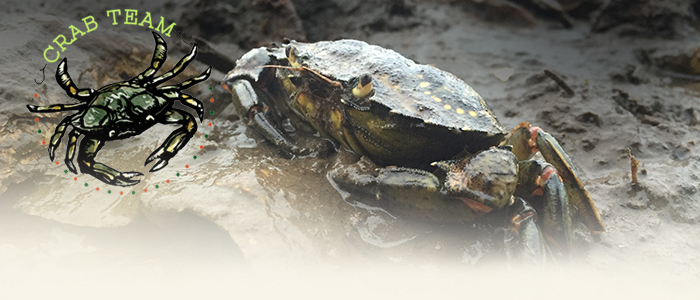
Crab Team’s Big Discovery!
August 4th, 2016
You might have heard the recent news that Crab Team volunteers captured the first confirmed European green crab in Washington’s inland waters (but if you haven’t, read our blog post). The single adult male was found in Westcott Bay, on San Juan Island, by Craig Staude, Jack Bell, Chris Wilson, and Bruce Robinson during the course of their regular monthly monitoring. This detection also resulted from the hard work of all 100 of the Crab Team volunteers working at the 26 sites currently being monitored.
Since April, volunteer monitors have recorded more than 10,000 individual crabs, and every single one, with the exception of this single green crab, was native. This crab is a needle in our haystack. On one hand, all of us were looking very hard for it. On the other, we kind of hoped never to see it. But we would rather know that it is there than pay the consequences for not knowing!
The sighting strongly supports that the Crab Team monitoring protocol can detect even small crab populations. The absolute best chance for effective intervention is to find and remove small populations when they pop up like this. The rarity of sightings so far suggests that it is a very lucky (or unlucky, really) event for a larval crab to get washed into our pocket estuaries. That means, if we can respond quickly and effectively, our removal efforts could have a lasting effect.
You will most certainly hear much more in the coming weeks about the response to the sighting. Stay tuned to the Crab Team blog for updates on our plans and findings as we head to San Juan Island to conduct an expanded trapping effort. Only once we further investigate the area surrounding Westcott Bay will we know whether there are more needles in this haystack that should concern us. If you are local to that area, join us on the evening of Tuesday, September 13th at Friday Harbor Labs for a public presentation (more info here).
In the meantime, this month, all Crab Team volunteers will be wrapping up their sampling for 2016, giving the gear a final rinse, and mailing in the data sheets. As of October, the tides and the weather become less favorable for trapping. Even the crabs seem to want to hunker down for the winter; they stop coming to our traps because they stop eating very much. Crab Team will return to the mud next spring to continue searching for more needles in our Salish Sea haystack. In the interim, you can expect to hear from us. Our winter newsletter will include reports on what we found this year (in addition to this green crab, of course), and what we plan for 2017. In the meantime,
Keep your eyes on the beach and your boots in the mud!
Crab Team
Zombie Crabs – Why Can’t We Get Those Here?
![The yellow blob under the abdominal flap is the externa of the female barnacle, Sacculina carcini. (By Auguste Le Roux (Own work) [GFDL (http://www.gnu.org/copyleft/fdl.html) or CC BY-SA 4.0-3.0-2.5-2.0-1.0 (http://creativecommons.org/licenses/by-sa/4.0-3.0-2.5-2.0-1.0)], via Wikimedia Commons)](https://wsg.washington.edu/wordpress/wp-content/uploads/Sacculina_carcini_Wikimedia-1024-300x203.jpg)
The yellow blob under the abdominal flap is not eggs, but the externa of a female barnacle, Sacculina carcini. (By Auguste Le Roux (Own work), via Wikimedia Commons)
In Europe, millions of zombie green crabs are roaming the shore. From the outside, you might not even realize they are brain dead, no longer truly a green crab, but have been transformed into a skittering, feasting, parasite-producing machine. Their metabolism has been co-opted, their reproductive system re-appropriated, their crabby will subjugated to the whims of the intruder they harbor – the parasitic barnacle Sacculina carcini.
Barnacle? That’s right. For these crabs infection is the stuff of horror films, but the monster in this case is not an animal we typically think of as gross or dangerous – though anyone who has tried to walk barefoot on a barnacle-encrusted rock might disagree. This species is one of a group of parasites called Rhizocephalans (meaning “root headed,” which will become clear later on). As free-swimming larvae, they look very much like other barnacles, progressing from a nauplius stage to a cypris – but here they diverge.
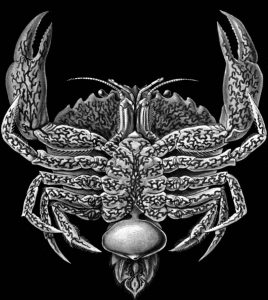
The great biological illustrator Ernst Haeckel visualized what the root-like interna of Sacculina carcini would look like inside the crab. And the blob of the externa is exposed by the folded back abdomen. (Wikipedia)
Imagine this: you are a European green crab, minding your own business, maybe poking around looking for some tasty polychaete worms or clams to eat, and you feel a slight tickle when something microscopic lands at the base of a hair on one of your legs, clinging to you by means of an antenna-like appendage. But you’re too distracted cruising around the shore to notice when the larvae — which has shed its shell, legs, eyes, and brain as it metamorphosed into a kentrogon (sounds like some kind of alien race, but is basically a sac of cells with a needle where the head used to be) — injects itself into your body through the base of that hair, and is released. Soon, the parasite attaches to your digestive system, and begins to grow thread-like structures that wrap around and along your nerves, like ivy growing up a tree – called the interna. The interna ultimately spread throughout your entire body, like the roots of a tree filling up a pot.
You might start to notice something going on when you begin to look like a female crab – that is, if you weren’t already female. One of the most bizarre effects of being infected with this barnacle is that, even though both sexes can be infected, male crabs are feminized by the parasite, causing them to have smaller claws and wider abdomens, like females (read a study on host feminization), paving the way for what happens next.
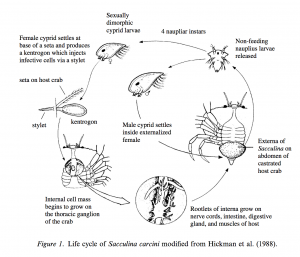
The life cycle of Sacculina carcini, from Goddard et al. 2005. Click to enlarge.
The barnacles that infect crabs are always female, and they use the crab as an egg factory, feeding off the crab and ultimately growing out through the underside of the crab to create a blobby structure called an externa, which is a large sac of barnacle reproductive tissue. The crab carries the externa just as if it were his or her own eggs. The barnacle eggs in the externa are fertilized by one or two free-swimming male cyprids, and then released as the next generation of zombifying parasites.
Needless to say, when you are carrying a sack of parasites on your abdomen, there’s no room for eggs of your own. Infected green crabs, both male and female, are fully castrated by the parasite. In addition, infection ultimately halts the process of molting, so crabs not only can’t grow any larger, but they also can’t replace any lost limbs. In spite of its gruesomeness, infection is not a death sentence for European green crabs; about half of the crabs infected in a laboratory experiment survived infection for at least 3 months. In the native range, some crabs also show scars on their carapace from carrying previous externae. However, those crabs can never recover their reproductive ability, and the female parasite can create multiple externae for the remaining life span of the crab.
How does this fit in with the global invasion of green crabs? In the native range of Carcinus maenas, about 16 percent of crabs are infected with Sacculina carcini (read the study), and given that about half of infected crabs die, this parasite could be a substantial part of population regulation. However, S. carcini has not followed European green crab to either the east or west coast of North America. It’s likely that the crabs that first traveled across the Atlantic Ocean, and later across the United States, were too young to bring the barnacle along as a hitchhiker. Additionally, because the male barnacle that fertilizes the female’s externa is free-swimming, the male and female barnacles need to make it to the new range at just the right times, but in different ways, which could be a very unlikely coincidence.
The lack of this, and other parasites, is one possible explanation for why European green crabs are larger here on the West Coast than they are in their native range (read the study). Combine a lack of parasites with relatively cold water (read the study), and it turns out that the biggest green crabs in the world have been found in the Pacific Northwest. Some claim to fame!
Your mind might already be leaping to the next logical question: Can we bring this parasite to help control populations of the European green crab on the West Coast? In the Salish Sea we do have native species of Rhizocephalan parasites, even some in the same group as this one. Nevertheless, it turns out bringing Sacculina carcini over is probably not a good idea. For those of you familiar with the history of cane toads in Australia, you’ll be relieved to hear that researchers here have been doing their homework when it comes to this parasite.
In a laboratory experiment in Santa Barbara, scientists tested whether several species of native crab could also be infected by Sacculina carcini. While more of the parasites settled on European green crab, when given the choice, they also settled on Dungeness crab and two species of shore crab that are found in our area (Hemigrapsus nudus and H. oregonensis). Dungeness crab were more likely to become infected with the parasite than any of the other species of crab, even when relatively few barnacles settled on them. What’s more, all of the native crabs that became infected died, compared to only about half of the European green crabs that were used for comparison, and many of the native crabs showed neurological impairment as a result of infection. A number of questions remain about whether the same patterns would occur in the field, but for now, the risk to native crabs is significant enough to warrant caution.
Creature Feature: Graceful Crab
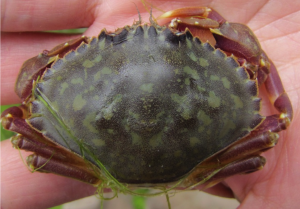 What’s the most abundant native crab in Puget Sound you’ve never heard of? Probably the graceful crab.
What’s the most abundant native crab in Puget Sound you’ve never heard of? Probably the graceful crab.
Most people have never heard of the graceful crab (Cancer (Metacarcinus) gracilis), despite how common it is. That’s because it looks very similar to a crab people often see on their dinner tables, Dungeness crab. The two species look so similar that many people mistake graceful crabs for young Dungeness crabs at first glance. The similarity between the two species speaks to their relateness; they share a genus name*, and are therefore as closely related as two distinct species can be.
The first clue you can use to tell the two crabs apart is their size. Despite their otherwise similar appearance, you would never accidentally catch and eat graceful crabs. That’s because they never grow as large as Dungies, and max out at about 4 ½ inches – well below the 6 ¼ inch minimum legal size for Dungies. At one time, Washington Department of Fish and Wildlife did promote a small recreational fishery for graceful crabs. But the confusion about which species people were taking made it difficult to regulate the fishery and ensure that young Dungeness crabs weren’t also being taken.
In our monitoring, Crab Team volunteers have to develop keen eyes and learn to distinguish the two species easily, even if they are the same size. Both graceful and Dungeness crabs live in the salt marshes and pocket estuaries where we sample, but Dungeness crabs only use those habitats when they are young, and move to deeper waters as grow large enough to avoid predators. So, when we see young Dungeness crabs in our traps, they are about the same size as graceful crabs.
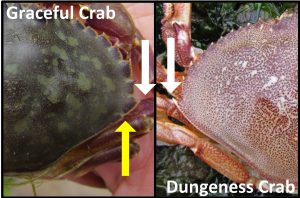
The widest tooth – indicated by the white arrows – is number 9 for graceful crabs, but 10 for Dungeness crabs. The yellow arrow shows the small notch behind the graceful crab’s widest tooth, which is really the 10th tooth. Note the smooth edge of the shell behind the Dungie’s widest tooth. Click to enlarge. (Photos: J. Adams)
How to tell the difference, then? It turns out that, similar to many of the other crab species, the key is in the teeth. On the edge of the back shell, the spines that jut out to the outside of either eye are called marginal teeth, and they are one of the best ways to tell different species of crabs apart. Being closely related, both Dungeness and graceful crabs have 10 marginal teeth on either side of their shell, but graceful crabs are widest at the ninth tooth, while Dungeness crabs are widest at the 10th – which is the spine that a recreational crabber uses to set the crab gauge.
Even if you only have a claw, you can figure out which species you are looking at. Dungeness and graceful crabs both have relatively long skinny pinchers, which are often called “pinching claws” for that reason, as opposed to the beefy crushing claws of rock crabs, for instance. But along the top edge of the claw, Dungeness crabs have serrations, while that edge is smooth on the claws of graceful crabs. Now you can impress your friends at beach parties!
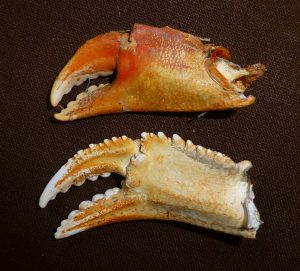
The top edge of the graceful crab claw, shown here on top, is smooth compared with the serrations on the top edge of the Dungeness crab claw, shown on the bottom. (Photo: E. Grason)
It’s more than just looks that separate the two species, though. According to research by Crab Team member Sean McDonald, graceful crabs’ metabolism is more efficient warmer water than Dungness crabs’, even when they are the same size. This might enable graceful crabs to be more successful in pocket estuaries and marshes, where the shallow waters can get quite warm in the summer.
One particularly surprising bit of graceful crab natural history is that the young crabs are adventurous travelers, and their preferred transportation is the fried-egg jelly (Phacellophora camtschatica). Most crabs have to settle onto the sea floor as they transition from free-swimming zoeal larvae to megalopae (see last issue of the newsletter for an explanation of the life stages of crabs). Even as megalopae, graceful crabs aren’t ready to come down yet, it seems, and prefer to spend a while longer floating around on the large jellies. A study in Santa Barbara found that during the warmer months, nearly all of the fried-egg jellies they collected had megalopae on them, and some graceful crabs stayed on their jelly-as-hot-air-balloon as they transitioned to juveniles. The researchers even investigated the crabs’ diets, and found that as megalopae, they eat bits of the jelly itself, and so are partially parasitic. However, as they grow into juvenile crabs, they switch to eating other parasites also found on the jelly, such as amphipods. In addition to a great view and amphipod buffet, graceful crabs in this commensal relationship benefit from a warm, protective relationship with the jellies. That is, the jellies often swim up near the surface, and the warmer surface water allows crabs to speed up development, and stay safe from predators, all without having to lift a claw. Maybe cruise ship is a better analogy than hot air balloon! Read the full research article..
Next time you find a small crab you at first take for a Dungie, take a closer look. You never know, you might very well have one of the Salish Sea’s graceful crabs.
*The name of the genus is contested, though the relatedness of the two crabs is not. After being known as Cancer for years and years, a recent change was adopted to Metacarcinus. However, there are still many who strongly contend that the crabs should remain in the genus Cancer, and only time will tell which taxonomist wins the day. For now we choose to acknowledge both names and call the crabs Cancer (Metacarcinus).
In addition to being a fantastic Crab Team crew, the Kala Krabbers are stars of radio drama, recently lighting up the airwaves of KPTZ Port Townsend Radio. Nan Evans, host of Nature Now, followed Captain Chris Jones, and Krabbers Eileen Cooney, Wendy Feltham and Katherine Jensen into the field with a microphone in July, and gave us all the chance to listen in to the sounds of Crab Team at work. Episode one tracked the group as they searched for molts, examined the shoreline, and set the traps, ending with the irresistible cliffhanger, “Tune in next time to see what they caught!” Episode two brought a sigh of relief when they didn’t turn up with any invasive green crabs.
This is the second year Chris has captained the Crab Team site at Kala Lagoon, where we have received special permission from the Kala Point homeowners association to sample this private lagoon. During 2015, our pilot year, Kala Lagoon was the closest monitoring site to the established population of green crabs in Sooke Inlet, BC. The question of exactly where and when green crab larvae could get washed onto Washington shorelines is a complex one, but habitats that are closer to a known source population have a greater chance of being invaded. It was important to us to make sure we were looking at high-risk habitats like Kala. Chris helped launch the site last year with two additional pioneering volunteers, Bonnie and Jay, whose work helped assure us that green crabs had not yet made it that far. This year, Captain Chris has trained up a crew of new recruits and, as you can hear on the radio program, the group works extremely well together – whatever the weather!
The lagoon is extensive, about 13 acres, but shallow across most of its area, and hosts among the densest populations of shore crabs of any our sites. So far this year, the Kala Krabbers have already counted 1,509 live shore crabs, and 1,163 molts. You can imagine that it takes a well-oiled machine to patiently but efficiently work your way through all of those crabs. Small Hemigrapsus are the most likely to be confused with European green crabs, because, of all of our native crabs, they are the closest in shape, size, and habitat. Sorting carefully to make sure a young green crab didn’t sneak by undetected in the crowd requires focus.
We know that the Kala Krabbers are always on the lookout, both while sampling and just cruising the beach. They helped us run a “Green Crab Preparedness Drill” earlier this year, when Wendy was out on the beach with Nan, and found a crab they had never seen before. Moreover, it appeared this female was carrying eggs! Thinking it could be a European green crab, Wendy quickly called several members of the Crab Team, sending photos via email. While we typically try to respond quickly to such contacts, this time, we were all unable to take Wendy’s call because we were all in a meeting together! Wendy and Nan consulted the nearby Port Townsend Marine Science Center (PTMSC) about the time we were able to get back to her. To our relief, they had found a native black clawed crab (Lophopanopeus bellus). This species isn’t nearly as common as shore crabs, and has a carapace of a similar shape to European green crab, so it was very good they checked! They demonstrated quick thinking and helped us practice our response to possible sightings.
Several of the Krabbers have a background in studying the natural world and the Crab Team benefits from their knowledge and observational skills. Captain Chris has a Husky background, with an M.S. in Fisheries Management from UW, and spent his career studying shellfish and salmon fisheries in Washington and around the world. Wendy is the President of the PTMSC Board, with a wealth of teaching and natural history experience. If you’re ever in the area on a low tide, you’re likely to see her walking the beach, and uploading particularly cool sightings and beautiful photos to the citizen science app iNaturalist. She has even started an iNaturalist project focusing on the Crabs of the World! Katherine joined the program for the thrill of scientific discovery: “it was kind of on my bucket list to participate and see what a real field science project with a formal protocol is like, and I’m hooked now! This is really fun!”
August will mark the one year anniversary of the launch of monitoring at Kala Lagoon (with of course a break in sampling from October through March), and we will start to glean the benefits of multi-year sampling. Already, Chris and other returning veterans from our pilot year have commented that they are starting to notice seasonal changes in the critters they catch, and the habitat at their sites. Even in low-energy spots like pocket estuaries, the shape of the shoreline can change dramatically because of seasonal differences in tides and weather. It can be very gratifying to spend a lot of time studying one place very closely, because you inevitably start to realize that there is a lot more going on below the surface of that shallow lagoon than you first imagined.
Listen to the KPTZ Nature Now series featuring the Kala Krabbers: Episode 1 and Episode 2
Photo Gallery
Here are some of our favorite scenes from summer sampling. We love to get the virtual experience of monitoring with all of the Crab Team volunteers – have a photo to share? Send it to crabteam@uw.edu.
